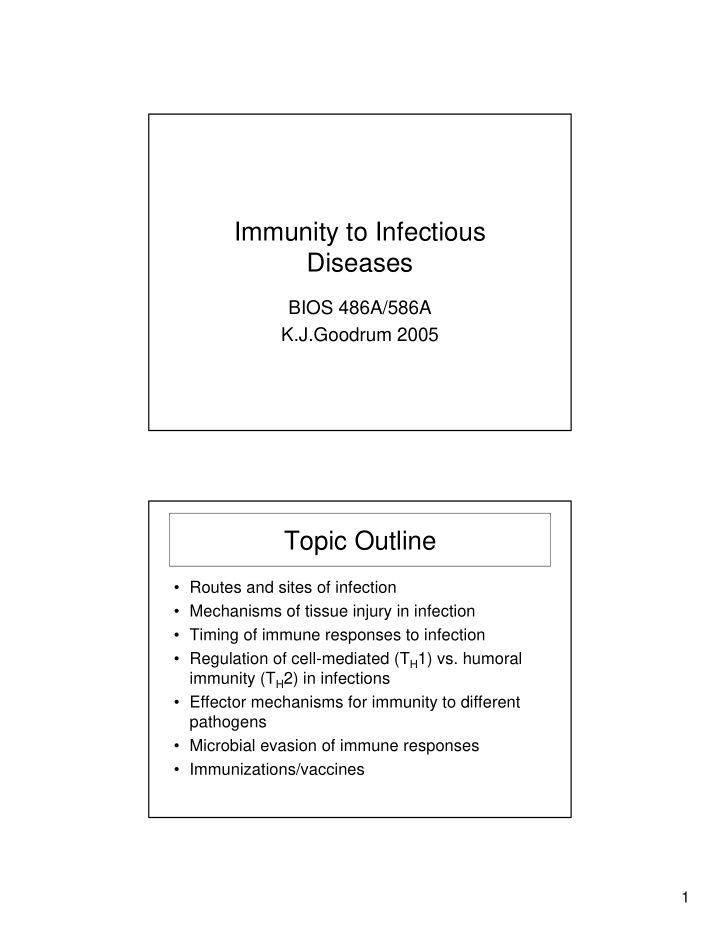



Immunity to Infectious Diseases BIOS 486A/586A K.J.Goodrum 2005 Topic Outline • Routes and sites of infection • Mechanisms of tissue injury in infection • Timing of immune responses to infection • Regulation of cell-mediated (T H 1) vs. humoral immunity (T H 2) in infections • Effector mechanisms for immunity to different pathogens • Microbial evasion of immune responses • Immunizations/vaccines 1
Primary Route of Infection: Microbial Adherence and Invasion of epithelial tissues (lung, gut, other) Janeway, Fig. 10.2 Primary Route of Infection: Microbial Adherence and Invasion of epithelial tissues (continued). Janeway, Fig. 10.2 2
Janeway. Fig. 10.4. Infection compartments Janeway. Fig. 10.5. Mechanisms of Pathogen- induced tissue Damage 3
Janeway. Fig. 10.5. Mechanisms of Pathogen- induced tissue Damage (continued) Janeway. Fig. 10.1. Time course of immune response to acute infection. 4
Janeway. Fig.10.9. Infection induced Th1 vs. Th2 responses. Janeway. Fig. 10.17. Protective Effector Mechanisms against various infectious microbes 5
Janeway. Fig. 10.17. Protective Effector Mechanisms against various infectious microbes (continued) Janeway. Fig. 10.17. Protective Effector Mechanisms against various infectious microbes (continued) 6
Janeway. Fig. 10.23. Mucosal γδ T cell function. Janeway. Fig. 10.24. Mucosal Secretory IgA function 7
Janeway. Fig. 10.27. Recognition of intracellular infection by Nod1. Janeway. Fig. 10.27. Recognition of intracellular infection by Nod1.(continued) 8
Janeway. Fig. 2.5. Innate recognition of microbes and phagocytosis by macrophages Janeway. Fig. 2.18. Microbial activation of complement pathways for inflammation. 9
Janeway. Fig. 9.1. Protective effector mechanisms of antibody. Janeway. Fig. 1.24 Protective effector mechanisms of antibody. 10
Janeway. Fig. 8.27. Effector T cell populations and effector mechanisms. Janeway. Fig. 11.1. Immune evasion via multiple antigenic variants of microbes (serotypes). 11
Fig.11.1 continued Fig. 11.1 continued 12
Janeway. Fig. 11.2. Immune Evasion via antigen drift/shift. Janeway. Fig. 11.2. Immune Evasion via antigen drift/shift. (continued) 13
Janeway. Fig. 11.3. Immune evasion via sequential DNA rearrangements of microbial antigens. Janeway. Fig. 11.3. Immune evasion via sequential DNA rearrangements of microbial antigens. (continued) 14
Janeway. Fig. 11.5. Immune evasion mechanisms of herpes viruses. Janeway. Fig. 11.5. Immune evasion mechanisms of herpes viruses. (continued) 15
Janeway. Fig. 11.5. Immune evasion mechanisms of herpes viruses. (continued) Janeway. Fig. 11.6. The effect of T helper subpopulations on leprosy outcome. 16
Janeway. Fig. 11.6. The effect of T helper subpopulations on leprosy outcome. (continued) Janeway. Fig. 14.21. Childhood vaccination schedule in USA. 17
Janeway. Fig. 14.23. Janeway. Fig. 14.23. continued. 18
Summary • Immunity to infection depends on a combination of innate mechanisms (phagocytosis, complement, etc.) and antigen specific adaptive responses (antibody, effector T lymphocytes). • The immune system regulates which specific responses predominate (humoral vs. cell- mediated) based on the body compartment infected (intracellular vs. extracellular) and on cytokine signals present at initial antigen contact (Th1 vs. Th2 responses). Summary-continued • Disease-causing microbes have virulence mechanisms that resist or evade innate and/or specific immune effector functions. • Recovery from natural infection or artificial immunization promote specific longterm immunity to re-infection (immunological memory). 19
Recommend
More recommend